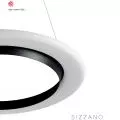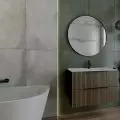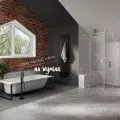Shelter for homeless animals in Szczecin
A&B: What has been the biggest challenge, and what has brought you the most satisfaction?
Katarzyna Opalinska: As always, when the functional program is complicated, the biggest challenge is to perfectly develop the functional layout and "dress" it in the right form. Especially since the program was subject to countless changes and modifications during the design process - as it usually happens when the theoretical data from the program tables begin to "live" on the developed plans. This, of course, makes the design process more difficult and slows it down, but one should be aware that the materials provided to the investor are for a deep analysis of how the building will function in the future, which is beneficial at this stage, not when the building already exists. The patience and determination of the designers, as well as the inquisitiveness and persistence of the investor's representatives, resulted in a reliably refined functional and spatial layout, which was finally accepted and intended for implementation, which was both a challenge and brought great satisfaction. We believe that the building has a chance to fit with its simple, natural and quite modest form into the context of its surroundings, and at the same time will fulfill its function as a comfortable place of residence and convalescence for animals deprived of a home, often harmed by fate, and a place of work for their caregivers and volunteers who passionately surrender to their mission to help them.
The central front pavilion includes an entrance area with a waiting room,
secretariat, adoption room and education room
© O2 Architects
A&B: How do you think such facilities should be designed?
Katarzyna Opalinska: As in any design process, an individual approach to the chosen location and efficient cooperation with the investor are of great importance. A sound analysis of the user's functional needs and regulations is the basis for a facility with such a complex structure to have a chance to function well. Since shelters for homeless animals are counted among the "onerous" functions, great emphasis should be placed on acoustic issues, the performance of appropriate analyses, the use of appropriate material and technological solutions. For us, it is important that the facility fit into the terrain through the spatial layout and the environment in general - the use of appropriate scale, natural, environmentally and user-friendly finishing materials. Nowadays, of course, it is also important to strive to make the building energy efficient, through the use of eco-technologies such as heat pumps, photovoltaic panels, green roofs, among others. We tried to include all these aspects in our design. From our point of view, it is also important to balance the ratio between the size of the designed space and its quality. In this case, we were fortunate that the investor also made the same assumption. The use of high-quality design solutions is likely to result in an attractive building and its surroundings, which will attract both volunteers to help, school groups for educational purposes, individuals with their own pets, and potential "customers" interested in adoption. All of this will create a vibrant space.
A&B: What factors should be considered during the design process?
Katarzyna Opalinska: The most important issue is the location, which of course lies with the investor. The issue of noise, which we mentioned in the previous point, makes plans for this type of development meet with a lot of opposition from the local community. There are plenty of ways to mitigate any acoustic inconvenience, and it is these that should be considered first. What is important is the designation of the land, as specified in the local zoning plan, the proper distance of the location from residential areas, the appropriate size of the plot intended for the investment and the prevailing ground conditions. It is necessary to provide for and ensure public and "private" access to the facility, issues of daily accessibility for outsiders, such as volunteers. Through the above-discussed locational conditions, issues of functional layout, legal regulations including construction, sanitary and fire regulations, we always come to the issue of the economic framework set by the investor, which largely affect the final shape of the facility. However, we are convinced that by consistently sticking to the key design assumptions based on deep analysis, even with a limited budget and unstable economic and political conditions, it is always possible to bring the investment to fruition and achieve the intended effect.
































